Citroen C4 DAG 2014.5 2.G Owner's Manual
Manufacturer: CITROEN, Model Year: 2014.5, Model line: C4 DAG, Model: Citroen C4 DAG 2014.5 2.GPages: 340, PDF Size: 12.89 MB
Page 131 of 340
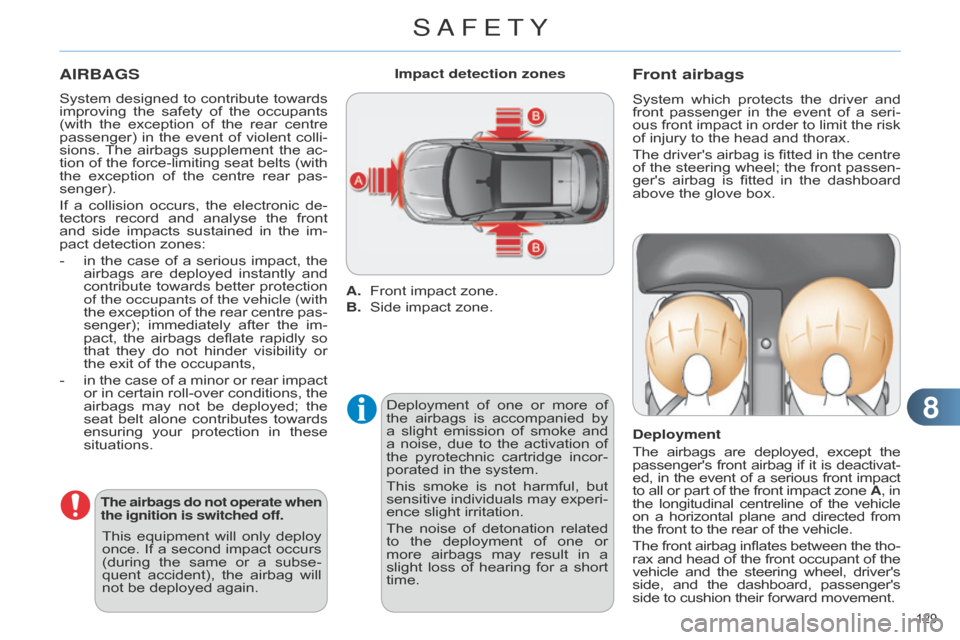
88
129
C4-2_en_Chap08_securite_ed01-2014
AIRBAGS
System designed to contribute towards improving
the safety of the occupants
(with
the
exception
of
the
rear
centre
passenger)
in
the
event
of
violent
colli-
sions.
The
airbags
supplement
the
ac
-
tion
of
the
force-limiting
seat
belts
(with
the
exception
of
the
centre
rear
pas
-
senger).
If
a
collision
occurs,
the
electronic
de
-
tectors
record
and
analyse
the
front
and
side
impacts
sustained
in
the
im
-
pact
detection zones:
-
in
the
case
of
a
serious
impact,
the
airbags
are
deployed
instantly
and
contribute
towards
better
protection
of the occupants of the vehicle (with
the
exception
of
the
rear
centre
pas
-
senger);
immediately
after
the
im
-
pact,
the
airbags
deflate
rapidly
so
that
they
do
not
hinder
visibility
or
the
exit of the occupants,
-
in
the
case
of
a
minor
or
rear
impact
or
in
certain
roll-over
conditions,
the
airbags
may
not
be
deployed;
the
seat
belt
alone
contributes
towards
ensuring
your
protection
in
these
situations.
The airbags do not operate when
the ignition is switched off.
A. Front impact zone.
B.
Side
impact zone.
Impact detection zones
Deployment
of
one
or
more
of
the
airbags
is
accompanied
by
a
slight
emission
of
smoke
and
a
noise,
due
to
the
activation
of
the
pyrotechnic
cartridge
incor
-
porated
in the system.
This
smoke
is
not
harmful,
but
sensitive
individuals
may
experi
-
ence
slight irritation.
The
noise
of
detonation
related
to
the
deployment
of
one
or
more
airbags
may
result
in
a
slight
loss
of
hearing
for
a
short
time.
Front airbags
System which protects the driver and front
passenger in the event of a seri -
ous
front
impact
in
order
to
limit
the
risk
of
injury to the head and thorax.
The
driver's
airbag
is
fitted
in
the
centre
of
the
steering
wheel;
the
front
passen
-
ger's
airbag
is
fitted
in
the
dashboard
above
the glove box.
Deployment
The
airbags
are
deployed,
except
the passenger's
front
airbag
if
it
is
deactivat
-
ed,
in
the
event
of
a
serious
front
impact to
all
or
part
of
the
front
impact
zone
A, in
the
longitudinal
centreline
of
the
vehicle on
a
horizontal
plane
and
directed
from the
front to the rear of the vehicle.
The
front
airbag
inflates
between
the
tho
-
rax
and
head
of
the
front
occupant
of
the vehicle
and
the
steering
wheel,
driver's side,
and
the
dashboard,
passenger's side
to cushion their forward movement.
This
equipment
will
only
deploy
once.
If
a
second
impact
occurs
(during
the
same
or
a
subse
-
quent
accident),
the
airbag
will
not
be
deployed
again.
SAFETY
Page 132 of 340
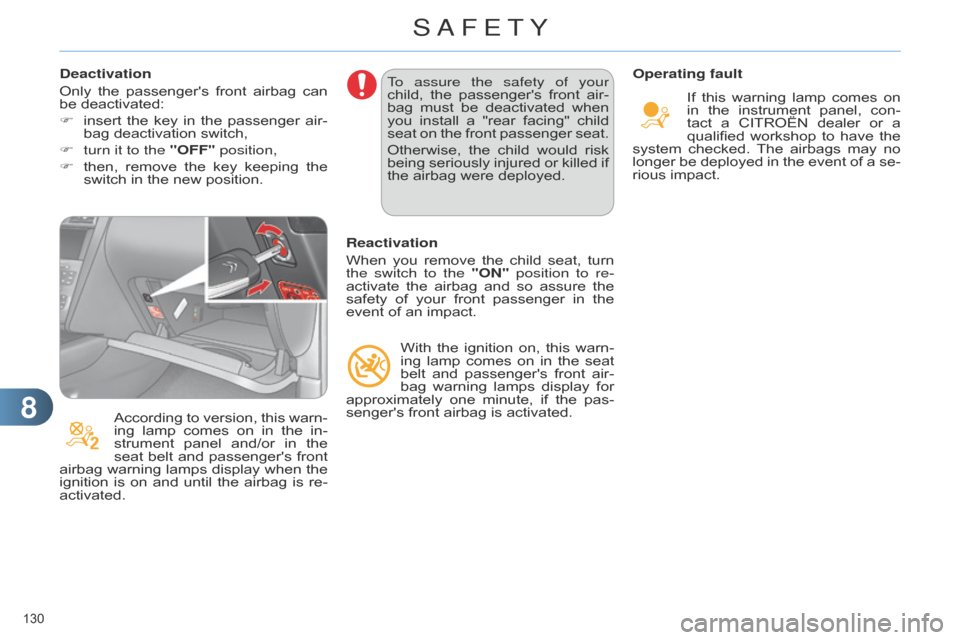
88
130
C4-2_en_Chap08_securite_ed01-2014
Deactivation
Only
the
passenger's
front
airbag
can
be
deactivated:
F
insert
the
key
in
the
passenger
air
-
bag
deactivation switch,
F
turn it to the
"OFF" position,
F
then,
remove
the
key
keeping
the
switch
in the new position.
According
to
version,
this
warn
-
ing
lamp
comes
on
in
the
in
-
strument
panel
and/or
in
the
seat
belt
and
passenger's
front
airbag
warning
lamps
display
when
the
ignition
is
on
and
until
the
airbag
is
re
-
activated. To assure the safety of your
child,
the
passenger's
front
air
-
bag
must
be
deactivated
when
you
install
a
"rear
facing"
child
seat
on
the
front
passenger
seat.
Otherwise,
the
child
would
risk
being
seriously
injured
or
kille
d
if
the
airbag were deployed.
Reactivation
When
you
remove
the
child
seat,
turn
the switch to the
"ON" position to re-
activate
the
airbag
and
so
assure
the
safety
of
your
front
passenger
in
the
event
of an impact.
With
the
ignition
on,
this
warn
-
ing
lamp
comes
on
in
the
seat
belt
and
passenger's
front
air
-
bag
warning
lamps
display
for
approximately
one
minute,
if
the
pas
-
senger's
front airbag is activated.Operating fault
If
this
warning
lamp
comes
on
in
the
instrument
panel,
con
-
tact
a
CITROËN
dealer
or
a
qualified
workshop
to
have
the
system
checked.
The
airbags
may
no
longer
be
deployed
in
the
event
of
a
se
-
rious
impact.
SAFETY
Page 133 of 340

88
131
C4-2_en_Chap08_securite_ed01-2014
Lateral airbags
System which protects the driver and front
passenger in the event of a seri -
ous
side
impact
in
order
to
limit
the
risk
of
injury
to
the
chest,
between
the
hip
and
the shoulder.
Each
lateral
airbag
is
fitted
in
the
seat
backrest
frame, door side.
Deployment
A
lateral
airbag
is
deployed
unilaterally
in the
event
of
a
serious
side
impact
applied to
all
or
part
of
the
side
impact
zone B,
perpendicular
to
the
longitudinal
cen
-
treline
of
the
vehicle
on
a
horizontal
plane and
directed
from
the
outside
towards
the inside
of the vehicle.
The
lateral
airbag
inflates
between
the
hip
and
shoulder
of
the
front
occupant
of
the
vehicle
and
the
corresponding
door
trim panel. A.
Front
impact zone.
B.
Side
impact zone.
Impact detection zones
Curtain airbags
System which
contributes towards im -
proving the protection of the driver and
passengers
(with
the
exception
of
the
rear
centre
passenger)
in
the
event
of
a
serious
side
impact
in
order
to
limit
the
risk
of
injury
to
the
side
of
the
head.
Each
curtain
airbag
is
built
into
the
pil
-
lars
and
the
upper
passenger
compart
-
ment
area.
Deployment
The
curtain
airbag
is
deployed
at
the
same
time
as
the
corresponding
lateral
airbag
in
the
event
of
a
serious
side
impact
applied
to
all
or
part
of
the
side
impact
zone
B
,
perpendicular
to
the
longitudinal
centreline
of
the
vehicle
on
a
horizontal
plane
and
directed
from
the
outside
towards
the
inside
of
the
vehicle.
The
curtain
airbag
inflates
between
the
front
or
rear
occupant
of
the
vehicle
and
the
windows.
SAFETY
Page 134 of 340
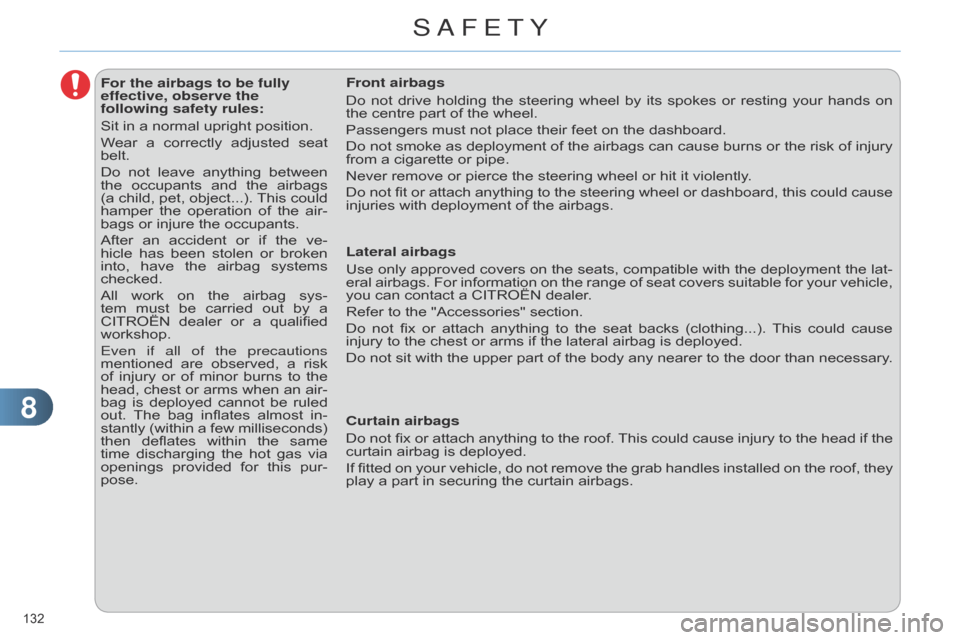
88
132
C4-2_en_Chap08_securite_ed01-2014
For the airbags to be fully
effective, observe the
following safety rules:
Sit in a normal upright position.
Wear
a
correctly
adjusted
seat
belt.
Do
not
leave
anything
between
the
occupants
and
the
airbags
(a
child,
pet,
object...).
This
could
hamper
the
operation
of
the
air
-
bags
or injure the occupants.
After
an
accident
or
if
the
ve
-
hicle
has
been
stolen
or
broken
into,
have
the
airbag
systems
checked.
All
work
on
the
airbag
sys
-
tem
must
be
carried
out
by
a
CITROËN
dealer
or
a
qualified
workshop.
Even if all of the precautions
mentioned
are
observed,
a
risk
of
injury
or
of
minor
burns
to
the
head,
chest
or
arms
when
an
air
-
bag
is
deployed
cannot
be
ruled
out.
The
bag
inflates
almost
in
-
stantly
(within
a
few
millis
econds)
then
deflates
within
the
same
time
discharging
the
hot
gas
via
openings
provided
for
this
pur
-
pose. Front airbags
Do
not
drive
holding
the
steering
wheel
by
its
spokes
or
resting
your
hands
on
the
centre part of the wheel.
Passengers
must not place their feet on the dashboard.
Do
not
smoke
as
deployment
of
the
airbags
can
cause
burns
or
the
risk
of
injury
from
a cigarette or pipe.
Never
remove or pierce the steering wheel or hit it violently.
Do
not
fit
or
attach
anything
to
the
steering
wheel
or
dashboard,
this
could
cause
injuries
with deployment of the airbags.
Lateral airbags
Use
only
approved
covers
on
the
seats,
compatible
with
the
deployment
the
lat
-
eral
airbags.
For
information
on
the
range
of
seat
covers
suitable
for
your
vehicle,
you
can contact a CITROËN dealer.
Refer
to the "Accessories" section.
Do
not
fix
or
attach
anything
to
the
seat
backs
(clothing...).
This
could
cause
injury
to the chest or arms if the lateral airbag is deployed.
Do
not
sit
with
the
upper
part
of
the
body
any
nearer
to
the
door
than
necessary
.
Curtain airbags
Do
not
fix
or
attach
anything
to
the
roof.
This
could
cause
injury
to
the
head
if
the
curtain
airbag is deployed.
If
fitted
on
your
vehicle,
do
not
remove
the
grab
handles
installed
on
the
roof,
they
play
a part in securing the curtain airbags.
SAFETY
Page 135 of 340
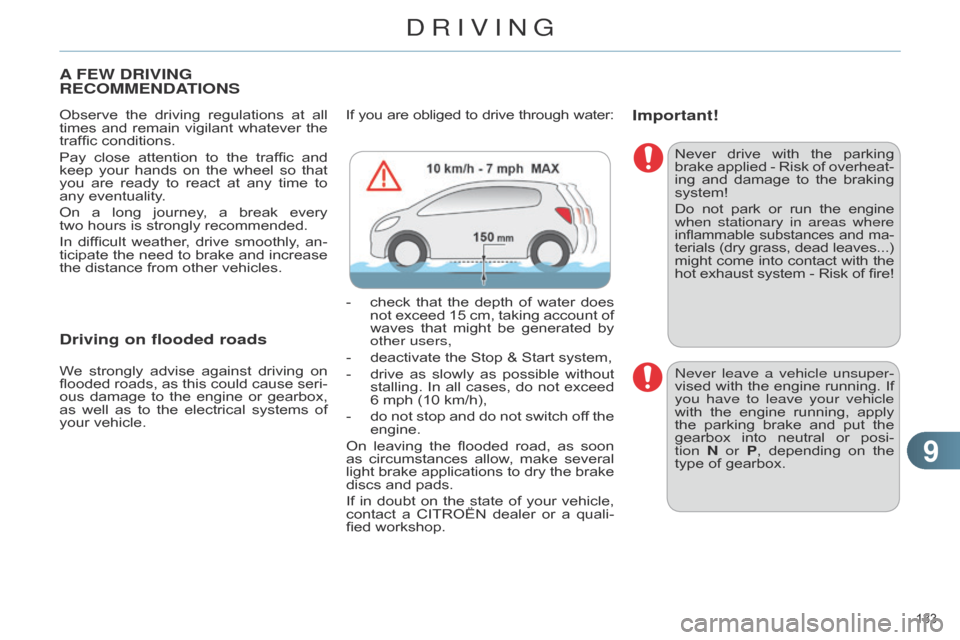
99
133
C4-2_en_Chap09_conduite_ed01-2014
A FEW DRIVING RECOMMENDATIONS
Observe the driving regulations at all times
and remain vigilant whatever the
traffic
conditions.
Pay
close
attention
to
the
traffic
and
keep
your
hands
on
the
wheel
so
that
you
are
ready
to
react
at
any
time
to
any
eventuality.
On
a
long
journey
,
a
break
every
two hours
is strongly recommended.
In
difficult
weather
,
drive
smoothly
,
an
-
ticipate
the
need
to
brake
and
increase
the
distance from other vehicles.
Driving on flooded roads
We strongly advise against driving on flooded
roads, as this could cause seri -
ous
damage
to
the
engine
or
gearbox,
as
well
as
to
the
electrical
systems
of
your
vehicle.
Important!
Never drive with the parking brake
applied - Risk of overheat -
ing
and
damage
to
the
braking
system!
Do
not
park
or
run
the
engine when
stationary in areas where
inflammable substances and ma -terials (dry grass, dead leaves...) might
come into contact with the hot
exhaust
system
-
Risk
of
fire!
n
ever leave a vehicle unsuper-
vised
with
the
engine
running.
If
you have to leave your vehicle
with
the
engine
running,
apply
the
parking
brake
and
put
the
gearbox
into
neutral
or
posi
-
tion
N
or P,
depending
on
the
type
of gearbox.
If
you
are
obliged
to
drive
through
water:
-
check
that
the
depth
of
water
does
not
exceed
15
cm,
taking
account
of
waves
that
might
be
generated
by
other users,
-
deactivate
the
Stop
&
Start
system,
-
drive
as
slowly
as
possible
without
stallin
g.
In
all
cases,
do
not
exceed
6
mph
(10
km/h),
-
do
not
stop
and
do
not
switch
of
f
the
engine.
On
leaving
the
flooded
road,
as
soon
as
circumstances
allow
,
make
several
light
brake
applications
to
dry
the
brake
discs
and
pads.
If
in
doubt
on
the
state
of
your
vehicle,
contact
a
CITROËN
dealer
or
a
quali
-
fied
workshop.
DRIVING
Page 136 of 340
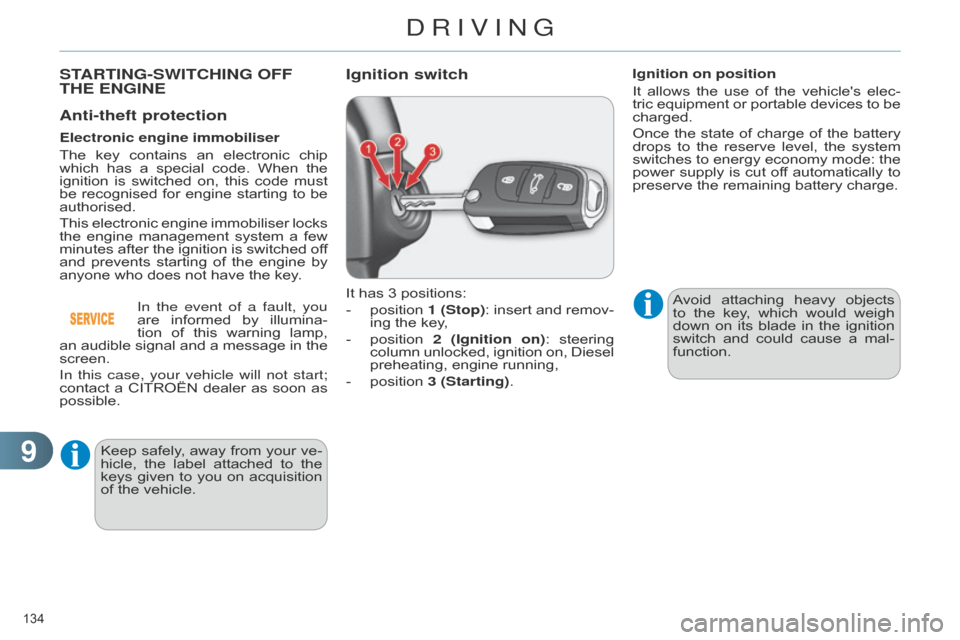
99
134
C4-2_en_Chap09_conduite_ed01-2014
Anti-theft protection
Electronic engine immobiliser
The
key
contains
an
electronic
chip
which
has
a
special
code.
When
the
ignition
is
switched
on,
this
code
must
be
recognised
for
engine
starting
to
be
authorised.
This
electronic
engine
immobiliser
locks
the
engine
management
system
a
few
minutes
after
the
ignition
is
switched
of
f
and
prevents
starting
of
the
engine
by
anyone
who does not have the key.
In the event of a fault, you
are
informed
by
illu
mina-
tion
of
this
warning
lamp,
an
audible
signal
and
a
message
in
the
screen.
In this case, your vehicle will not start;
contact
a
CITROËN
dealer
as
soon
as
possible. It
has 3 positions:
-
position
1
(Stop):
insert
and
remov
-
ing
the key,
-
position
2 (Ignition on)
:
steering
column
unlocked,
ignition
on,
Diesel
preheating,
engine running,
-
position
3 (Starting).Avoid
attaching
heavy
objects
to
the
key
,
which
would
weigh
down
on
its
blade
in
the
ignition
switch
and
could
cause
a
mal
-
function.
Ignition on position
It
allows
the
use
of
the
vehicle's
elec
-
tric
equipment
or
portable
devices
to
be
charged.
Once
the state of charge of the battery drops
to the reserve level, the system
switches
to
energy
economy
mode:
the
power
supply
is
cut
of
f
automatically
to
preserve
the remaining battery charge.
Keep
safely
,
away
from
your
ve
-
hicle,
the
label
attached
to
the
keys
given
to
you
on
acquisition
of
the vehicle.
STARTING-SWITCHING OFF THE ENGINEIgnition switch
DRIVING
Page 137 of 340
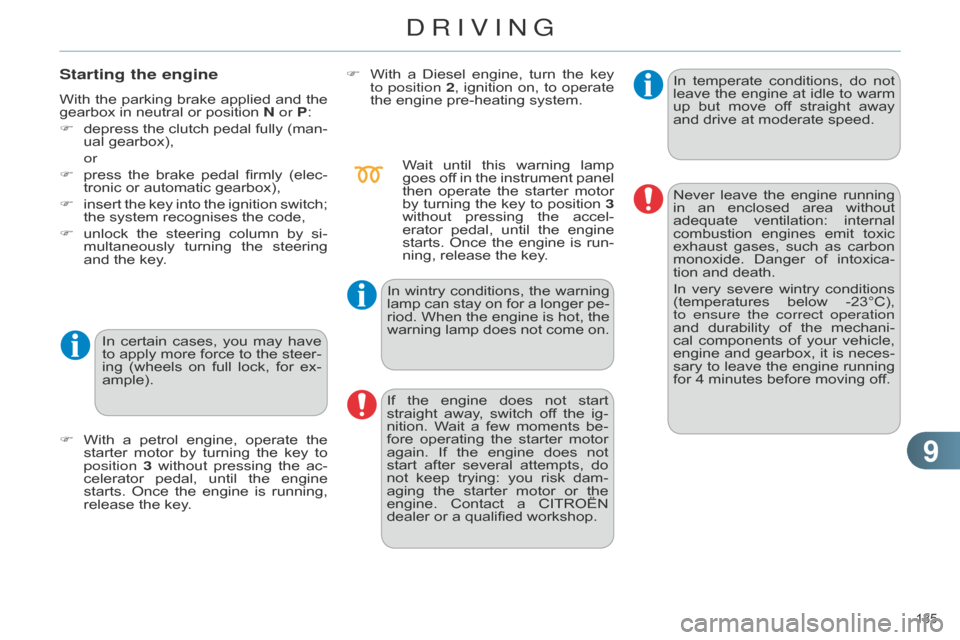
99
135
C4-2_en_Chap09_conduite_ed01-2014
Starting the engine
With the parking brake applied and the gearbox
in neutral or position N or P:
F
depress
the
clutch
pedal
fully
(man
-
ual
gearbox),
or
F
press
the
brake
pedal
firmly
(elec
-
tronic
or automatic gearbox),
F
insert
the
key
into
the
ignition
switch;
the
system recognises the code,
F
unlock
the
steering
column
by
si
-
multaneously
turning
the
steering
and
the key.
In
certain
cases,
you
may
have
to
apply more force to the steer-
ing
(wheels
on
full
lock,
for
ex
-
ample).
F
With
a
petrol
engine,
operate
the
starter
motor
by
turning
the
key
to
position 3
without
pressing
the
ac
-
celerator
pedal,
until
the
engine
starts.
Once
the
engine
is
running,
release
the key. F
With
a
Diesel
engine,
turn
the
key
to position
2, ignition on, to operate the
engine pre-heating system.
Wait
until
this
warning
lamp
goes
of
f
in
the
instrument
panel
then
operate
the
starter
motor
by
turning
the
key
to
position 3
without
pressing
the
accel
-
erator
pedal,
until
the
engine
starts.
Once
the
engine
is
run
-
ning,
release the key.
In
wintry
conditions,
the
warning
lamp
can
stay
on
for
a
longer
pe
-
riod.
When
the
engine
is
hot,
the
warning
lamp
does
not
come
on.
If
the
engine
does
not
start
straight
away
,
switch
of
f
the
ig
-
nition.
W
ait
a
few
moments
be
-
fore
operating
the
starter
motor
again.
If
the
engine
does
not
start
after
several
attempts,
do
not
keep
trying:
you
risk
dam
-
aging
the
starter
motor
or
the
engine.
Contact
a
CITROËN
dealer
or a qualified workshop.In
temperate
conditions,
do
not
leave
the engine at idle to warm up
but move of f straight away
and
drive at moderate speed.
Never
leave
the
engine
running
in
an
enclosed
area
without
adequate
ventilation:
internal
combustion
engines
emit
toxic
exhaust
gases,
such
as
carbon
monoxide.
Danger
of
intoxica
-
tion
and death.
In
very
severe
wintry
conditions
(temperatures
below
-23°C),
to ensure the correct operation
and
durability
of
the
mechani
-
cal
components
of
your
vehicle,
engine
and
gearbox,
it
is
neces
-
sary
to
leave
the
engine
running
for
4 minutes before moving off.
DRIVING
Page 138 of 340

99
136
C4-2_en_Chap09_conduite_ed01-2014
Key left in the "Ignition on"
position
On
opening
the
driver's
door
,
an
alert
message
is
displayed,
ac
-
companied
by
an
audible
signal,
to
remind
you
that
the
key
is
still
in
the
ignition
switch
at
posi
-
tion
1 (Stop).
If
the
key
has
been
left
in
the
igni
-
tion switch at position 2 (Ignition
on),
the
ignition
will
be
switched
of
f automatically after one hour.
To
switch
the
ignition
back
on,
turn
the
key
to
position
1 (Stop)
,
then
back
to
position
2 (Ignition
on)
.Switching off the engine
F Stop the vehicle.
F
With
the
engine
running
at
idle,
turn
the
key to position 1.
F
Remove
the
key
from
the
ignition
switch.
F
T
o
lock
the
steering
column,
turn
the
steering
until it locks. Energy economy mode
After
switching of f the engine (posi -
tion 1-Stop ), for a maximum of 30 min -
utes you can still use functions such
as
the
audio
and
telematic
system,
the
wipers,
dipped
beam
headlamps,
cour
-
tesy
lamps, ...
For
more
information,
refer
to
the
"Practical
information"
sec
-
tion,
under
"Energy
economy
mode".
T
o
facilitate
unlocking
of
the
steer
-
ing
column,
it
is
recommended that
the
wheels
be
returned
to the
straight
ahead
position
before switching
off the engine.
F
Check
that
the
parking
brake
is
cor
-
rectly
applied,
particularly
on
sloping ground.Never
switch
of
f
the
ignition
be
-
fore
the
vehicle
is
at
a
complete
stop.
With
the
engine
of
f,
the
braking
and
steering
assistance
systems
are
also
cut
of
f:
risk
of
loss
of control of the vehicle.
When you leave the vehicle,
keep
the
key
with
you
and
lock
the
vehicle.
DRIVING
Page 139 of 340
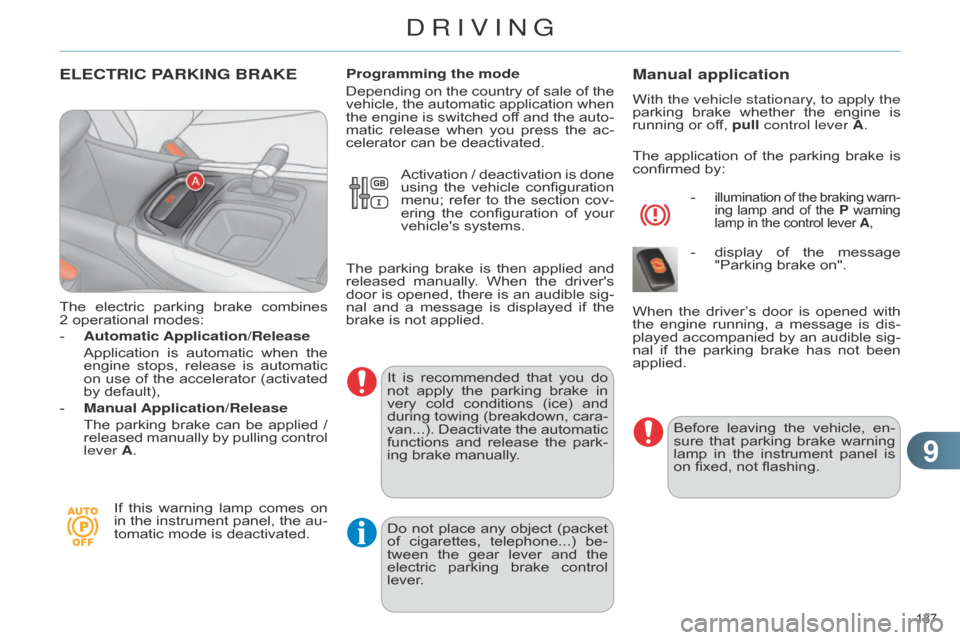
99
137
C4-2_en_Chap09_conduite_ed01-2014
ELECTRIC PARKING BRAKE
The electric parking brake combines 2 operational
modes:
-
Automatic Application/Release
Application
is
automatic
when
the
engine
stops,
release
is
automatic
on
use
of
the
accelerator
(activated
by
default),
-
Manual Application/Release
The
parking
brake
can
be
applied
/
released
manually
by
pullin
g
control
lever
A.
If
this
warning
lamp
comes
on
in
the
instrument
panel,
the
au
-
tomatic
mode is deactivated.Programming the mode
Depending
on
the
country
of
sale
of
the
vehicle,
the
automatic
application
when
the
engine
is
switched
of
f
and
the
auto
-
matic
release
when
you
press
the
ac
-
celerator can be deactivated.
It
is
recommended
that
you
do
not
apply
the
parking
brake
in
very
cold
conditions
(ice)
and
during
towing
(breakdown,
cara
-
van...).
Deactivate
the
automatic
functions
and
release
the
park
-
ing
brake manually.
Manual application
With the vehicle stationary, to apply the
parking brake whether the engine is
running
or off, pull control lever A.
The
application
of
the
parking
brake
is
confirmed
by:
-
illumination of the braking warn -
ing lamp and of the P warning lamp
in the control lever A,
- display of the message "Parking
brake on".
Before
leaving
the
vehicle,
en
-
sure
that
parking
brake
warning
lamp
in
the
instrument
panel
is
on
fixed, not flashing.
When
the
driver
’s
door
is
opened
with
the
engine
running,
a
message
is
dis
-
played
accompanied
by
an
audible
sig
-
nal
if
the
parking
brake
has
not
been
applied.
Activation
/
deactivation
is
done
using
the
vehicle
configuration
menu;
refer
to
the
section
cov
-
ering
the
configuration
of
your
vehicle's
systems.
The
parking
brake
is
then
applied
and
released
manually
.
When
the
driver's
door
is
opened,
there
is
an
audible
sig
-
nal
and
a
message
is
displayed
if
the
brake
is
not
applied.
Do
not
place
any
object
(packet
of
cigarettes,
telephone...)
be
-
tween
the
gear
lever
and
the
electric
parking
brake
control
lever
.
DRIVING
Page 140 of 340
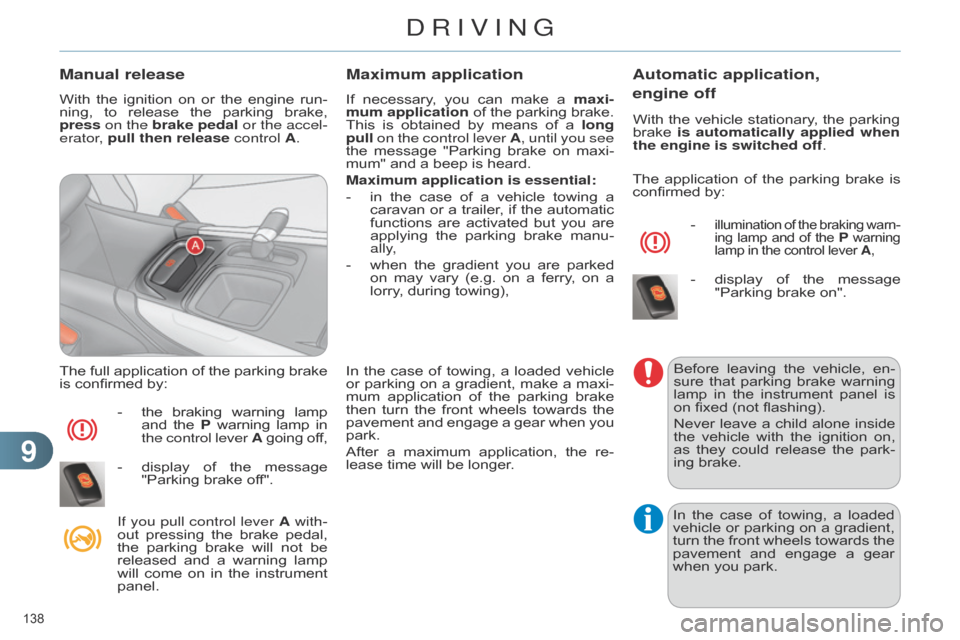
99
138
C4-2_en_Chap09_conduite_ed01-2014
Manual release
With the ignition on or the engine run -
ning, to release the parking brake,
press
on the brake pedal or the accel-
erator, pull then release control A.
The
full
application
of
the
parking
brake
is
confirmed by:
-
the
braking
warning
lamp and
the
P warning
lamp
in the control lever
A
going
of
f,
-
display
of
the
message
"Parking
brake off".
If you pull control lever A with-
out
pressing
the
brake
pedal,
the
parking
brake
will
not
be
released
and
a
warning
lamp
will
come
on
in
the
instrument
panel.
Maximum application
If necessary, you can make a maxi -
mum application of the parking brake.
This
is
obtained
by
means
of
a
long
pull
on the control lever A, until you see
the
message
"Parking
brake
on
maxi
-
mum"
and a beep is heard.
Maximum application is essential:
-
in
the
case
of
a
vehicle
towing
a
caravan
or
a
trailer
,
if
the
automatic
functions
are
activated
but
you
are
applying
the
parking
brake
manu
-
ally,
-
when
the
gradient
you
are
parked
on
may
vary
(e.g.
on
a
ferry
,
on
a
lorry
, during towing),
In
the
case
of
towing,
a
loaded
vehicle
or
parking
on
a
gradient,
make
a
maxi
-
mum
application
of
the
parking
brake
then
turn
the
front
wheels
towards
the
pavement
and
engage
a
gear
when
you
park.
After
a
maximum
application,
the
re
-
lease
time will be longer.
Automatic application,
engine off
- illumination of the braking warn -
ing lamp and of the P warning lamp
in the control lever A,
- display of the message "Parking
brake on".
Before
leaving
the
vehicle,
en
-
sure
that
parking
brake
warning
lamp
in
the
instrument
panel
is
on
fixed (not flashing).
Never
leave
a
child
alone
inside
the
vehicle
with
the
ignition
on,
as
they
could
release
the
park
-
ing
brake.
In
the
case
of
towing,
a
loaded
vehicle
or
parking
on
a
gradient,
turn
the
front
wheels
towards
the
pavement
and
engage
a
gear
when
you park.
The
application
of
the
parking
brake
is
confirmed
by:
With
the
vehicle
stationary
,
the
parking
brake
is
automatically applied when
the engine is switched off.
DRIVING